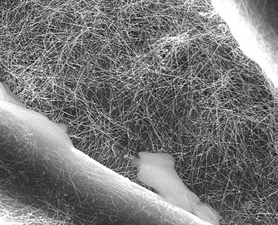|
|
America has some of the cleanest drinking water on earth, but in many developiong countries, clean water is oftentimes hard to come by. Bacteria and other nasty organisms give rise to such waterborne illnesses as cholera, typhoid and hepatitis. |
Zap, They're Dead! New Water Filter Electrocutes Bacteria
Many scientists are working on inexpensive and simple technologies that can clean water and make it safe to drink. Among them are Yi Cui and his colleagues at
Just about everyone I know has some type of water-filtering pitcher in their refrigerator, or one hooked up directly to their faucet. While those filters physically trap most bacteria from flowing into water, this new nanofilter actually lets bacteria flow right through.
 Instead, those bacteria pass through several layers of cotton where an electrical field zaps them with twenty volts of electricity for several seconds. It's a technique that researchers have dubbed conductive "nano-coated" cotton. Twenty volts is barely enough to make a human tingle, but tests found that more than 98 percent of Escherichia coli bacteria were killed instantly.
Instead, those bacteria pass through several layers of cotton where an electrical field zaps them with twenty volts of electricity for several seconds. It's a technique that researchers have dubbed conductive "nano-coated" cotton. Twenty volts is barely enough to make a human tingle, but tests found that more than 98 percent of Escherichia coli bacteria were killed instantly.
And because the voltage is so low, it doesn't require serious electricity generation. A person could generate the power from a stationary bike or a hand-cranked device. No pumping is required either. The force of gravity is enough to allow the water and it's nasties to pass through the cotton and get zapped!
Cui and the team created this nanofilter by dipping plain cotton cloth in a high-tech broth full of silver nanowires and carbon nanotubes. They used cotton because you can find it anywhere in the world, and they used a "negligible" amount of silver, all in an effort to keep costs low.
"It can easily be used in remote areas where people don't have access to chemical treatments such as chlorine," said Cui.

 Previous page
Previous page Back to top
Back to top







